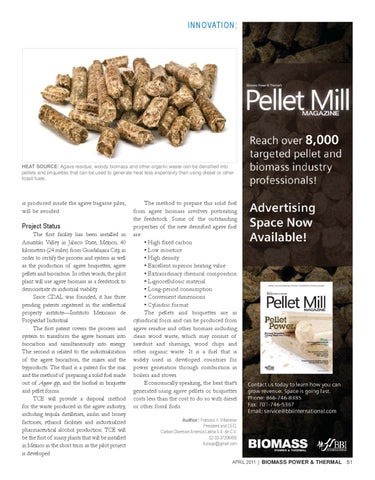INNOVATION¦
HEAT SOURCE: Agave residue, woody biomass and other organic waste can be densified into pellets and briquettes that can be used to generate heat less expensivly than using diesel or other fossil fuels.
is produced inside the agave bagasse piles, will be avoided.
Project Status The first facility has been installed in Amatitán Valley in Jalisco State, Mexico, 40 kilometers (24 miles) from Guadalajara City, in order to certify the process and system as well as the production of agave briquettes, agave pellets and biocarbon. In other words, the pilot plant will use agave biomass as a feedstock to demonstrate its industrial viability. Since CDAL was founded, it has three pending patents registered in the intellectual property institute—Instituto Mexicano de Propiedad Industrial. The first patent covers the process and system to transform the agave biomass into biocarbon and simultaneously into energy. The second is related to the industrialization of the agave biocarbon, the mixes and the byproducts. The third is a patent for the mix and the method of preparing a solid fuel made out of Agave spp, and the biofuel in briquette and pellet forms. TCE will provide a disposal method for the waste produced in the agave industry, including tequila distilleries, inulin and honey factories, ethanol facilities and industrialized pharmaceutical alcohol production. TCE will be the first of many plants that will be installed in Mexico in the short term as the pilot project is developed.
The method to prepare this solid fuel from agave biomass involves pretreating the feedstock. Some of the outstanding properties of the new densified agave fuel are: • High fixed carbon • Low moisture • High density • Excellent superior heating value • Extraordinary chemical composition • Lignocellulosic material • Long-period consumption • Convenient dimensions • Cylindric format The pellets and briquettes are in cylindrical form and can be produced from agave residue and other biomass including clean wood waste, which may consist of sawdust and shavings, wood chips and other organic waste. It is a fuel that is widely used in developed countries for power generation through combustion in boilers and stoves. Economically speaking, the heat that’s generated using agave pellets or briquettes costs less than the cost to do so with diesel or other fossil fuels. Author: Franciso X. Villasenor President and CEO, Carbon Diversion America Latina S.A. de C.V. 52-33-37206455 fcoxvpv@gmail.com
APRIL 2011 | BIOMASS POWER & THERMAL 51
